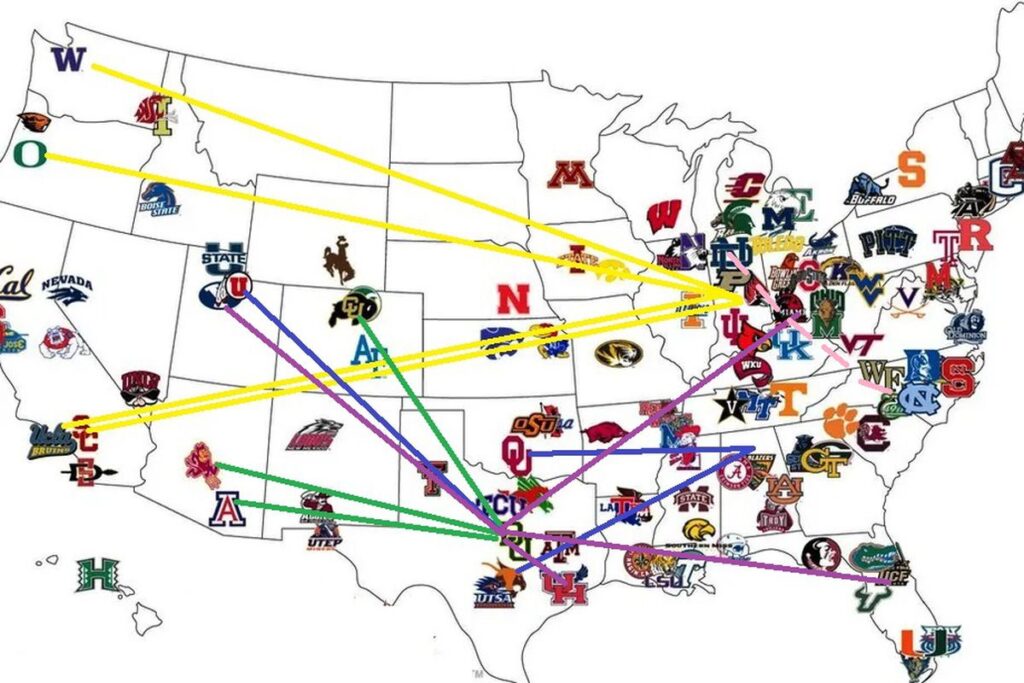2024 College Football Shakeup: Who's Moving Where in the Conference Realignment

College football is poised for a transformative shift in 2024, heralding a new era that promises to drastically alter the landscape of the sport as we know it. In recent years, fans and analysts alike have grappled with the implications of the transfer portal (which is really making our college football depth charts more difficult) and Name, Image, and Likeness (NIL) agreements, sparking lively debates and reshaping the core dynamics of college football. However, these changes pale in comparison to what’s on the horizon: the comprehensive conference realignment coupled with the introduction of a new 12-team playoff format is set to shake the very foundations of the sport.
This seismic shift in college football’s structure and competitive balance is not just a minor tweak in the rules or a simple expansion of teams; it’s a complete overhaul of the traditional system that has governed the sport for decades. The conference realignment will see historic rivalries upended, traditional powerhouses repositioned, and new alliances forged, fundamentally altering the competitive landscape. Moreover, the expansion to a 12-team playoff format opens the doors to a more inclusive and dynamic postseason, promising more high-stakes matchups and unexpected outcomes.
As we stand on the brink of this new era, the college football community is buzzing with anticipation, curiosity, and even a hint of apprehension. How will these sweeping changes impact the sport’s traditions, fan loyalties, and the overall competitive spirit? Will the new playoff format enhance the excitement of the college football season, or will it dilute the significance of the regular season? These questions and many more loom large as we inch closer to the 2024 season, marking a pivotal moment in the history of college football. Let’s delve into the specifics of these changes and explore what they mean for the future of this beloved sport.
New Era of SEC Football
The 2024 college football conference realignment is significantly impacting the SEC (Southeastern Conference), with major changes in its team composition and structure. Oklahoma and Texas are set to join the SEC in 2024, expanding the conference to 16 teams. This addition marks a significant shift for the conference, which has historically been a powerhouse in college football.
One of the notable changes accompanying this expansion is the elimination of divisions within the SEC. Starting from 2024, the conference will no longer be divided into East and West divisions. Instead, the SEC will adopt a structure where all teams will be part of a single group. This change is expected to impact the scheduling of games, with teams playing eight conference games. The top two teams, based on their performance, will then compete in the SEC championship game in Atlanta.
These changes are part of a broader transformation across the college football landscape, driven by factors such as television rights, the 12-team College Football Playoff, NIL (Name, Image, and Likeness) agreements, and the transfer portal, which have all influenced roster management and the dynamics of the sport.
The inclusion of Oklahoma and Texas in the SEC is particularly noteworthy. These schools bring their rich football traditions and competitive strengths to the conference, which is likely to intensify the level of competition within the SEC. The realignment thus not only reshapes the geographical and competitive landscape of the conference but also sets the stage for new rivalries and dynamic matchups in the coming seasons.

SEC Teams in 2023:
- Total Teams: 14
- Members: Alabama, Arkansas, Auburn, Florida, Georgia, Kentucky, LSU, Mississippi, Mississippi State, Missouri, South Carolina, Tennessee, Texas A&M, Vanderbilt
SEC Teams in 2024:
- Total Teams: 16
- Members: Alabama, Arkansas, Auburn, Florida, Georgia, Kentucky, LSU, Mississippi, Mississippi State, Missouri, Oklahoma, South Carolina, Tennessee, Texas, Texas A&M, Vanderbilt
While the schedules are going to be more difficult for most teams, the Florida Gators are the extreme example with easily the most difficult schedule of the 2024 season. Just take a look at the final 5 game where the Gators will face 5 teams likely to be in the playoff hunt:
- vs Georgia (Jacksonville, FL)
- at Texas
- vs LSU
- vs Ole Miss
- at FSU
Re-learning what is considered a good record will be tough for football fans to understand come playoff time.
New Era of Big 10 Football
The conference realignment for 2024 is bringing significant changes to Big Ten football. One of the most notable developments is the expansion of the conference to include four new teams: the Washington Huskies, Oregon Ducks, UCLA Bruins, and the USC Trojans. This expansion will increase the total number of teams in the Big Ten to 18 for the 2024-25 season.
In addition to the expansion in the number of teams, the Big Ten is also changing its structure. The conference will do away with its traditional East and West Divisions and move to a single-division format. This means that the two best teams, regardless of geographic location, will compete in the conference championship game at the end of the season. This shift is a departure from the previous division-based system and is expected to impact how the regular season games are scheduled and played.
The addition of these prominent teams from the West Coast not only brings new markets and viewership to the Big Ten but also increases the competitiveness of the conference. Schools like USC and Oregon have strong football programs with a history of success, which could shake up the traditional power dynamics within the Big Ten.

Big Ten Teams in 2023:
- Total Teams: 14
- Members: Illinois, Indiana, Iowa, Maryland, Michigan, Michigan State, Minnesota, Nebraska, Northwestern, Ohio State, Penn State, Purdue, Rutgers, Wisconsin
Big Ten Teams in 2024:
- Total Teams: 18
- Members: Illinois, Indiana, Iowa, Maryland, Michigan, Michigan State, Minnesota, Nebraska, Northwestern, Ohio State, Oregon, Penn State, Purdue, Rutgers, Southern California (USC), UCLA, Washington, Wisconsin
The move of USC and UCLA to the Big Ten in 2024 will likely necessitate adjustments in their football strategies, particularly when it comes to playing late-season games in colder climates. Both teams, traditionally based in the milder weather of Southern California, may find the snowy and icy conditions of Midwestern Novembers challenging. Adapting to these conditions could involve changes in their playing style, with a potential increase in focus on a power-running game and a stout defensive strategy to cope with the elements. This shift could be a stark contrast to the typically pass-heavy, fast-paced style often associated with West Coast teams. The ability to adapt to these new environmental and competitive challenges will be crucial for their success in the Big Ten.
New Era of Big 12 Football
The Big 12 conference is undergoing significant changes due to the 2024 college football realignment. The most notable change is the departure of the Oklahoma Sooners and Texas Longhorns to the SEC. This shift will reduce the conference back to 12 teams after a brief period of expansion in 2023 when the BYU Cougars, Cincinnati Bearcats, Houston Cougars, and UCF Knights joined, bringing the total to 14 teams.
The 2024 season will see new additions to the Big 12, with Arizona, Arizona State, Colorado, and Utah joining the conference. This expansion will bring the total number of teams back up to 16. This reshuffling of teams will impact the dynamics within the conference, as it loses two traditionally strong programs in Oklahoma and Texas but gains fresh competition with the new additions.
The Big 12 will continue to play nine conference games, and the scheduling format will ensure that each school plays one another at least once every two years. The elimination of divisions is another significant change. These adjustments are part of the conference’s efforts to adapt to the evolving landscape of college football, influenced by factors like television rights, NIL, the transfer portal, and the new 12-team College Football Playoff format.
With these changes, the Big 12’s competitiveness and its representation in the expanded College Football Playoff could be impacted. The departure of Oklahoma, a team that has had multiple playoff appearances, and the introduction of new teams could reshape the conference’s dynamics and its performance on the national stage.

Big 12 Teams in 2023:
- Total Teams: 14
- Members: BYU, Baylor, Cincinnati, Central Florida (UCF), Houston, Iowa State, Kansas, Kansas State, Oklahoma, Oklahoma State, TCU, Texas, Texas Tech, West Virginia
Big 12 Teams in 2024:
- Total Teams: 16
- Members: Arizona, Arizona State, BYU, Baylor, Cincinnati, Central Florida (UCF), Colorado, Houston, Iowa State, Kansas, Kansas State, Oklahoma State, TCU, Texas Tech, Utah, West Virginia
The Death of PAC-12 Football
The Pac-12 Conference is facing a dramatic transformation in 2024, with only Oregon State and Washington State remaining, marking a significant reduction from its previous size. This drastic change, caused by the departure of key teams to other conferences, is likely to have profound effects on the competitive landscape and overall visibility of Pac-12 football.

Pac-12 Teams in 2023:
- Total Teams: 12
- Members: Arizona, Arizona State, California, Colorado, Oregon, Oregon State, Stanford, Southern California (USC), UCLA, Utah, Washington, Washington State
Pac-12 Teams in 2024:
- Total Teams: 2
- Members: Oregon State, Washington State
The ACC Grows in 2024
The ACC football landscape is set for some additions in 2024 due to the conference realignment. The addition of Cal, Stanford, and SMU to the ACC will expand the conference to 17 teams, making it one of the largest power conferences in the country. This expansion has necessitated a revamp of the scheduling format, moving away from divisions and implementing a new system to accommodate the enlarged conference. The ACC aims to preserve key rivalries while introducing new matchups, indicating a mix of traditional and fresh competitive dynamics within the conference.

ACC Teams in 2023:
- Total Teams: 14
- Members: Boston College, Clemson, Duke, Florida State, Georgia Tech, Louisville, Miami, North Carolina, North Carolina State, Pittsburgh, Syracuse, Virginia, Virginia Tech, Wake Forest
ACC Teams in 2024:
- Total Teams: 17
- Members: Boston College, California, Clemson, Duke, Florida State, Georgia Tech, Louisville, Miami, North Carolina, North Carolina State, Pittsburgh, SMU, Stanford, Syracuse, Virginia, Virginia Tech, Wake Forest
American Athletic Conference
American Athletic Conference (AAC) Teams in 2023:
- Total Teams: 14
- Members: Charlotte, East Carolina, Florida Atlantic, Memphis, Navy, North Texas, Rice, SMU, South Florida, Temple, Tulane, Tulsa, UAB, UTSA
American Athletic Conference (AAC) Teams in 2024:
- Total Teams: 14
- Members: Army, Charlotte, East Carolina, Florida Atlantic, Memphis, Navy, North Texas, Rice, South Florida, Temple, Tulane, Tulsa, UAB, UTSA
Conference USA
Conference USA Teams in 2023:
- Total Teams: 9
- Members: Florida International, Jacksonville State, Liberty, Louisiana Tech, Middle Tennessee State, New Mexico State, Sam Houston State, UTEP, Western Kentucky
Conference USA Teams in 2024:
- Total Teams: 10
- Members: Florida International, Jacksonville State, Kennesaw State, Liberty, Louisiana Tech, Middle Tennessee State, New Mexico State, Sam Houston State, UTEP, Western Kentucky
Mid-American Conference
Mid-American Conference (MAC) Teams in 2023:
- Total Teams: 12
- Members: Akron, Ball State, Bowling Green, Buffalo, Central Michigan, Eastern Michigan, Kent State, Miami (Ohio), Northern Illinois, Ohio, Toledo, Western Michigan
Mountain West Conference
Western Athletic Conference (WAC) Teams in 1996:
- Total Teams: 16
- Members: Air Force, BYU, Colorado State, Fresno State, Hawaii, New Mexico, Rice, San Diego State, San Jose State, SMU, TCU, Tulsa, UNLV, Utah, UTEP, Wyoming
Mountain West Conference (MWC) Teams in 2024:
- Total Teams: 12
- Members: Air Force, Boise State, Colorado State, Fresno State, Hawaii, Nevada, New Mexico, San Diego State, San Jose State, UNLV, Utah State, Wyoming
Sun Belt Conference
Sun Belt Conference Teams in 2001:
- Total Teams: 7
- Members: Arkansas State, Idaho, Louisiana-Lafayette, Louisiana-Monroe, Middle Tennessee State, New Mexico State, North Texas
Sun Belt Conference Teams in 2024:
- Total Teams: 14
- Members: Appalachian State, Arkansas State, Coastal Carolina, Georgia Southern, Georgia State, James Madison, Louisiana-Lafayette, Louisiana-Monroe, Marshall, Old Dominion, South Alabama, Southern Mississippi, Texas State, Troy
Independants
FBS Independents in 2023:
- Total Teams: 4
- Members: Army, Connecticut (UConn), Massachusetts (UMass), Notre Dame
FBS Independents in 2024:
- Total Teams: 3
- Members: Connecticut (UConn), Massachusetts (UMass), Notre Dame
